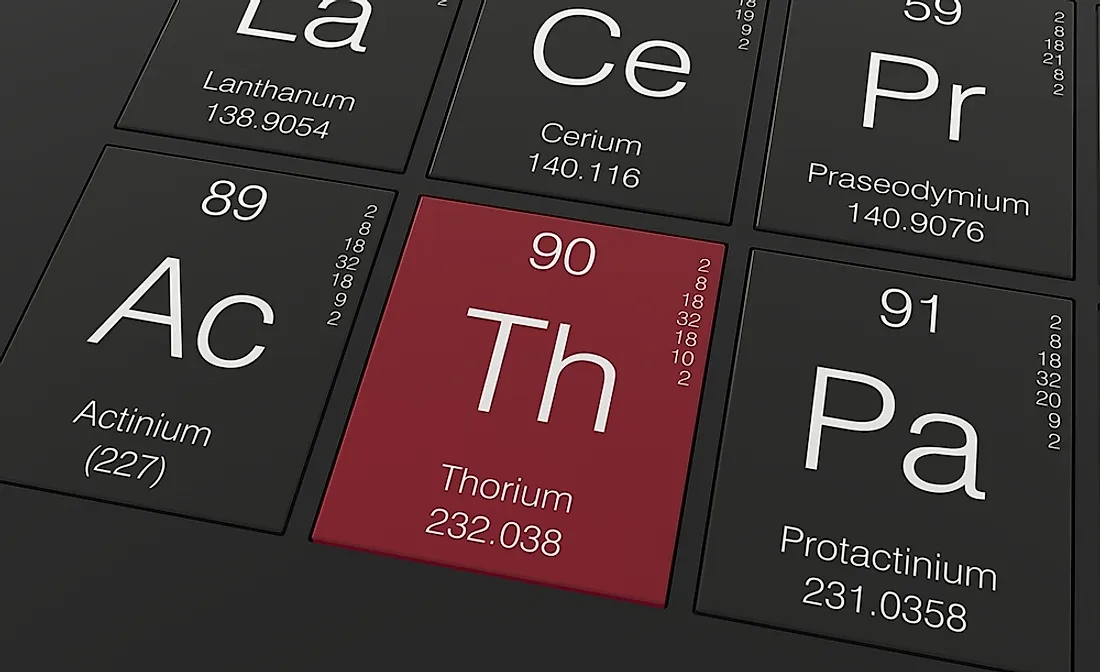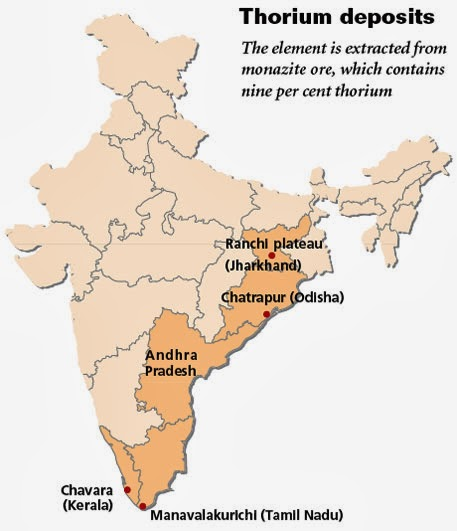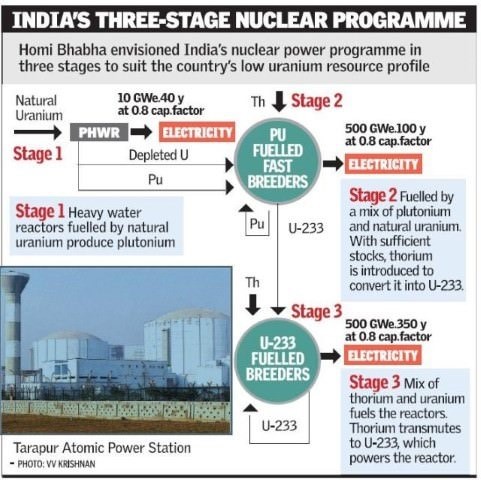Description

Copyright infringement not intended
Picture Courtesy: https://www.worldatlas.com/articles/list-of-countries-by-thorium-reserves.html
Context: India's thorium-rich deposits in Kerala and Odisha are essential for an indigenous nuclear power program.
Thorium
- Thorium (Th) is a weekly radioactive metal that gives an olive-grey colour when exposed to air, forming thorium dioxide (ThO2).
- It is moderately soft and malleable, with a high melting point.
- Thorium is estimated to be over three times more abundant than uranium in the Earth's crust.
- It is primarily extracted from monazite sands as a by-product during the extraction of rare-earth metals.
- Historically, thorium found applications in high-end optics, scientific instrumentation, vacuum tubes, gas mantles, and as a strengthening element in alloys. Its radioactivity became widely recognized in the early 20th century, leading to reduced use over time.
- Thorium is still used as an alloying element in welding electrodes, although its use is gradually declining. It finds applications in strengthening magnesium, coating tungsten wire, controlling grain size in tungsten for lamps, high-temperature crucibles, and glasses for optical instruments.
- Thorium has been proposed as a potential nuclear fuel in advanced reactor designs due to its abundance and unique nuclear properties.
Thorium Reserves in India
- India has significant thorium reserves, estimated at 11.93 million tonnes of in-situ resources of monazite; Kerala and Odisha alone contribute over 70% of India's thorium reserves.

Thorium in Nuclear Energy
- Thorium serves as a fertile material for nuclear fission, producing Uranium-233 when irradiated in a reactor.
- India's first indigenous fast breeder reactor at Kalpakkam, Tamil Nadu, has demonstrated the feasibility of using thorium as a fuel source.
Three-Stage Nuclear Power Programme
- Natural Uranium Phase: Utilising natural uranium in Pressurised Heavy Water Reactors (PHWRs).
- Plutonium Phase: Reprocessing spent fuel from PHWRs to obtain plutonium for use in Fast Breeder Reactors (FBRs).
- Thorium Phase: Large-scale utilisation of thorium with bred Uranium-233 from FBRs.
International Landscape
- China, the US, UK, and Japan are actively exploring thorium-based nuclear technologies.
- India aims to achieve energy self-sufficiency and reduce dependence on foreign uranium supplies through thorium utilisation.
India's Collaborations
- Collaboration with the US includes the potential sale of nuclear reactors and joint development of small modular reactor technologies.
- Negotiations with France for new Pressurised Reactors at Jaitapur have stalled due to unresolved issues.
- India's nuclear cooperation with Canada and Russia involves uranium supply and technology transfer for small modular reactors.
What are the Challenges?
- Thorium-based nuclear technology requires significant research and development investments to develop efficient thorium fuel cycles.
- India's three-stage nuclear power program, aimed at utilising thorium in nuclear reactors, necessitates advanced technological capabilities and infrastructure.
- Regulatory and safety concerns must be addressed to ensure the safe deployment of thorium-based reactors.
- International cooperation and collaboration are essential for accessing advanced technologies and expertise in thorium utilisation.

India has taken several steps to leverage its thorium reserves:
- Research and development efforts focused on thorium-based nuclear reactor designs, such as the Prototype Fast Breeder Reactor (PFBR) and Advanced Heavy Water Reactor (AHWR).
- Collaborative projects with international partners to advance thorium-based nuclear technologies.
- Investments in scientific research institutions and nuclear facilities to support thorium fuel cycle development.
- Policy initiatives and frameworks to promote the utilisation of thorium in the energy sector.
Future Outlook
- Thorium-based systems hold promise for decarbonizing India's energy sector and achieving energy security and sustainable development goals.
- Continued investment in research and development to overcome technical challenges associated with thorium-based nuclear technology.
- Strengthening international collaborations to access expertise and resources for advancing thorium fuel cycle technologies.
- Developing regulatory frameworks and safety standards specific to thorium-based nuclear reactors.
- Enhancing public awareness and engagement regarding the benefits and safety aspects of thorium-based nuclear energy.
Conclusion
- India's significant thorium reserves represent a strategic asset for the country's energy future. With focused research, technological innovation, and international cooperation, India can harness its thorium resources to achieve energy security, reduce carbon emissions, and promote sustainable development through advanced nuclear technologies.
Must Read Articles:
India’s Nuclear Power Programme
Source:
Down to Earth
|
PRACTICE QUESTION
Q. The cost of building and maintaining nuclear power plants can be significant. The price of renewable energy sources like solar and wind is constantly decreasing. How to ensure that nuclear power remains economically competitive in a constantly evolving energy market?
|













